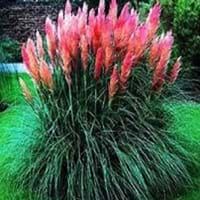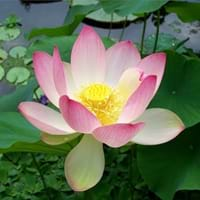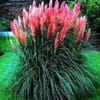Life Span
Perennial
Perennial
Origin
South America, Argentina
Southern Asia
Types
Not Available
Not Available
Number of Varieties
Not Available
Habitat
All sorts of environments
Ponds
USDA Hardiness Zone
7-11
9-12
AHS Heat Zone
12 - 7
12-3
Sunset Zone
H1, 3a, 3b, 4, 5, 6, 7, 8, 9, 10, 11, 12, 13, 14, 15, 16, 17, 18, 19, 20, 21, 22, 23, 24
21,22
Habit
Arching/Fountain-shaped
Clump-Forming
Flower Color
Pink
White, Red, Pink, Light Pink, Hot Pink, Rose, Coral
Flower Color Modifier
Bicolor
Bicolor
Fruit Color
Non Fruiting Plant
Non Fruiting Plant
Leaf Color in Spring
Green, Gray Green
Lime Green, Sea Green
Leaf Color in Summer
Light Green
Lime Green, Sea Green
Leaf Color in Fall
Green, Gray Green
Lime Green, Sea Green
Leaf Color in Winter
Green, Gray Green
Not Available
Leaf Shape
long with sharp edges
Orbicular
Plant Season
Spring, Summer, Fall, Winter
Summer, Fall
Sunlight
Full Sun, Partial Sun, Partial shade
Full Sun, Partial Sun
Type of Soil
Loam, Sand
Clay, Loam
The pH of Soil
Acidic, Neutral, Alkaline
Neutral
Soil Drainage
Well drained
Poorly Drained
Bloom Time
Early Summer, Summer, Late Summer, Early Fall
Late Spring, Early Summer, Summer, Late Summer
Tolerances
Pollution, Salt, Soil Compaction
Wet Site
Where to Plant?
Ground
Container, In Water, Pot
How to Plant?
Divison, Seedlings, Transplanting
From Rhizomes, Seedlings
Plant Maintenance
Medium
Medium
Watering Requirements
Do not water excessively, Keep the ground moist but not water-logged
Requires 4 to 8 inches of water above the soil line
In Summer
Lots of watering
Lots of watering
In Spring
Moderate
Moderate
In Winter
Average Water
Average Water
Soil pH
Acidic, Neutral, Alkaline
Neutral
Soil Type
Loam, Sand
Clay, Loam
Soil Drainage Capacity
Well drained
Poorly Drained
Sun Exposure
Full Sun, Partial Sun, Partial shade
Full Sun, Partial Sun
Pruning
Prune before Winter, Remove damaged leaves, Remove dead branches, Remove dead leaves
Cut away fading foliage
Fertilizers
10-10-10 diluted liquid fertilizer, All-Purpose Liquid Fertilizer
20N–4.4P–16.6K at 20-d intervals
Pests and Diseases
Free of serious pests and diseases
Aphids, Caterpillars
Plant Tolerance
Drought, moderate salt tolerance
Drought
Flower Petal Number
Single
Single, Double, Semi-Double
Foliage Texture
Fine
Bold
Foliage Sheen
Matte
Matte
Invasive
Sometimes
Sometimes
Attracts
Birds, songbirds, Wildlife
Beetles, Insects
Allergy
sneezing
Constipation
Aesthetic Uses
Beautification, Informal Hedge, Mixed Border, Ornamental use, Showy Purposes
Beautification
Beauty Benefits
Not Available
Promotes healthy skin, Provides herbal hair care
Environmental Uses
Air purification
Air purification
Medicinal Uses
No Medicinal Use
Antidiarrhoeal, Astringent, Cancer, Cardiotonic, Febrifuge, Hypotensive, Resolvent, Stomachic, Tonic
Part of Plant Used
Flowering Tips, Stem, Whole plant
Flowers, Leaves, Root, Seeds, Stem
Other Uses
Showy Purposes
Leaves are used to wrap small parcels, Roasted seed is used as a coffee substitute, Root is used as a vegetable
Used As Indoor Plant
Sometimes
Yes
Used As Outdoor Plant
Yes
Yes
Garden Design
Dried Flower/Everlasting, Feature Plant, Foundation, Hedges, Screening / Wind Break
Feature Plant, Tropical, Water Gardens
Botanical Name
CORTADERIA selloana 'Carminea Rendatleri'
NELUMBO nucifera
Common Name
Pampas Grass, Pink Pampas Grass
East Indian Lotus, Sacred Lotus
In Hindi
Pink Pampas grass
पवित्र कमल
In German
Pink Pampas grass
Heiliges Lotus
In French
Herbe Pampas rose
Lotus Sacré
In Spanish
Hierba de color rosa Pampas
loto sagrado
In Greek
Pink Pampas grass
ιερή Lotus
In Portuguese
Grama de Pampas rosa
Lotus sagrado
In Polish
Różowy Pampas trawy
Sacred Lotus
In Latin
Pink Pampas grass
sacra Lotus
Phylum
Tracheobionta
Magnoliophyta
Class
Liliopsida
Magnoliopsida
Order
Cyperales
Proteales
Family
Poaceae
Nymphaeaceae
Clade
Not Available
Angiosperms, Eudicots
Tribe
Not Available
Not Available
Subfamily
Not Available
Nelumbonaceae
Number of Species
Not Available
Not Available
Importance of Pink Pampas Grass and Sacred Lotus
Want to have the most appropriate plant for your garden? You might want to know the importance of Pink Pampas Grass and Sacred Lotus. Basically, these two plants vary in many aspects. Compare Pink Pampas Grass and Sacred Lotus as they differ in many characteristics such as their life, care, benefits, facts, etc. Every gardener must at least have the slightest clue about the plants he wants to plant in his garden. Compare their benefits, which differ in many ways like facts and uses. The medicinal use of Pink Pampas Grass is No Medicinal Use whereas of Sacred Lotus is Antidiarrhoeal, Astringent, Cancer, Cardiotonic, Febrifuge, Hypotensive, Resolvent, Stomachic and Tonic. Pink Pampas Grass has beauty benefits as follows: Not Available while Sacred Lotus has beauty benefits as follows: Not Available.
Compare Facts of Pink Pampas Grass vs Sacred Lotus
How to choose the best garden plant for your garden depending upon its facts? Here garden plant comparison will help you to solve this query. Compare the facts of Pink Pampas Grass vs Sacred Lotus and know which one to choose. As garden plants have benefits and other uses, allergy is also a major drawback of plants for some people. Allergic reactions of Pink Pampas Grass are sneezing whereas of Sacred Lotus have Constipation respectively. Having a fruit bearing plant in your garden can be a plus point of your garden. Pink Pampas Grass has showy fruits and Sacred Lotus has no showy fruits. Also Pink Pampas Grass is not flowering and Sacred Lotus is not flowering . You can compare Pink Pampas Grass and Sacred Lotus facts and facts of other plants too.





